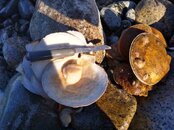I was with @stuartv and another buddy Saturday, as Stuart said we were all new to scooters, we all purchased Blacktips and this was the first time we all had them in the water. @DA Aquamaster was aweseome enough to show up with his as well and give us some pointers, I feel like if he hadn't been there we would have all been second guessing our scooter purchases. The first few minutes were definitely humbling, but after a few adjustments to tow cord and a few changes to approach/technique it started to settle in and make sense.
At least 2 of the 4 of us had the DeWalt 12 Ah batteries, I had the Waitley 9 Ah batteries, I cannot remember for sure what the 4th person had. I found this to be very accurate:
My first dive was a roller coaster ride, 40 minutes of up and down the gears on the trigger, we were on the trigger almost the whole time, and I spent extended time at speeds 5 and 6, popping higher than that for brief moments. Had I stayed on speed 3 or 4 I feel like I would have had a lot more battery left. I didn't check what my batteries were at between dives, I wish I would have. On the next dive I spent about 10-15 min at speeds 3/4 steadily before I really started to lose power. The Blacktip was at 2 bars when I got back in the water for Dive 2, after maybe 5-8 min it dropped to one bar. You could really tell when it began to lose power, I was in gear 4 and my buddy right behind me was keeping pace at speeds 1 and 2. Eventually it died so I hitched a ride with my buddy, as we got back I tried it again and was able to get a little more juice out of it, just enough to get me back to the dock. I pulled the batteries when I got out, one said 17%, the other 18%. The two with me that had DeWalt 12 Ah batteries still had plenty of battery power. The 9.0 Ah Waitleys having roughly 60% the run time of the DeWalt 12 Ah seems very accuarate to me. My original plan was to purchase 2 sets of Waitley 9 Ah, now I am rethinking that. I feel like with the DeWalt 12 Ah on most dives I do I wouldn't have to carry a second set of batteries. So it was definitely good to run the batteries to the end and see the true extent.
I had never been on a scooter before, so I don't have a lot to compare to, but so far I am impressed with this one, especially at the runtimes I saw with the bigger batteries. I am nowhere close to setting foot in a cave, so this scooter right now is plenty for me. A few things I would like to be different:
-The damn trim issue. It's honestly not enough to second guess the scooter, it's just enough to annoy me having to reposition it every time I let off the trigger. If a longer or different tube would offset this that would be awesome.
-I'd like to have more control over the speed settings, delays, start speed, etc. From what I understand the Piranhas are fully programmable like this, though I could have misunderstood that. I don't even know if this is possible with the electronics inside the Blacktip, but I would be interested in that, even if it was an add-on module.
All in all though, I am impressed after comparing this scooter on paper to others and then getting it in the water. Would I be more impressed with a Piranha P2? For sure. But it's not in the budget, it's not what I need for the diving I do, so it was never considered. At this price point this scooter was low enough priced that I could justify it as making sense in my budget even if it only goes out with me sometimes. I really feel like there wasn't a scooter out there until now that fit into this category, which may be a huge market - those who want more than an older Mako but less than a full technical DPV.
I also had 9 Ah batteries installed. On the first dive, I had about 20 minutes on the trigger, mostly at speed 4 or 5, but with a brief burst at 8 while I followed Stuart who I suspect was going "Whoooo!". Dive 2 was almost entirely at speed 2 or 3 as we went all the way around the lake. I pulled the batteries when I got home and I had 57% and 58% respectively. So I had a plenty of run time left at speed three.
The reasons for that are probably three fold:
1) An awareness of battery capacity and asense for how much you've got and how fast you can afford to go. Larger batteries will let you go farther, or let you go faster, or both. With a smaller battery you have to pick one or the other.
That said, if you are splitting it up over two dives, and switch batteries between dives, you'll be able to run rings around a diver with a single set of 12 Ah batteries. It takes about 2 hours to recharge a set of 9 Ah batteries and about 2.5 hours to recharge 12 Ah batteries. With maybe 60 minutes of charge time in a typical 90 minute surface interval, even if the 12 Ah battery diver gets a partial recharge, you still have an edge or at worse are at no disadvantage with a pair of 9 Ah batteries. You can buy three sets of 9 AH Waitley batteries for the price of a single set of 12 Ah DeWalts.
Where 12 Ah batteries make sense is on a single dive where you need more range, or more speed over the entire dive.
2) The more you dive a DPV, the more efficient you will get. Dive Xtras speed and range numbers are conservative (unlike the often very optimistic numbers posted by other companies. That said, I can beat the posted Dive Xtras speeds in speed runs, due to a cleaner than average gear configuration and very good buoyancy and trim.
Less than perfect buoyancy takes a huge hit on efficiency. If your buoyancy isn't spot on, you end up having to divert some of the thrust with a vertical vector to offset the positive or negative buoyancy. New DPV divers won't do as good a job of estimating and correcting buoyancy changes with depth change (if they think about it at all) and won't notice the buoyancy issue until they stop and either cork or plummmet to the bottom.
Similarly, any excess drag in your configuration has a large effect on speed and range. Parasitic drag is a square function where going twice as fast adds four times the drag, so you'll see a much greater loss of efficiency at higher speeds.
Trim is also important. If you find yourself using your fins to hold your legs up, that's coming at the cost of increased drag. Similarly, if you can feel the prop wash on your stomach or legs, then you are down in the prop wash and you're losing a lot of efficiency as well.
It takes awhile to get good enough with a DPV to become efficient with the DPV and it's just part of the normal learning curve.
3) I'll pm you with this one, and we can take care of that next time you get down to NC.






